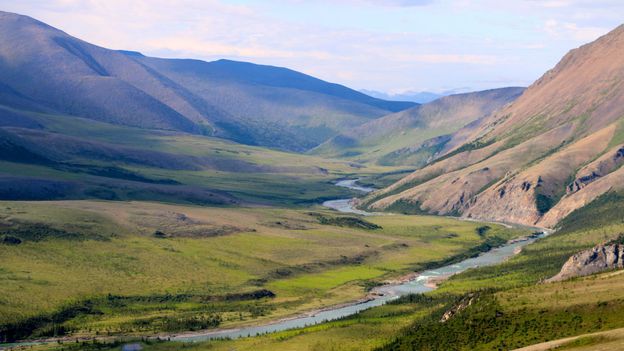Features correspondent
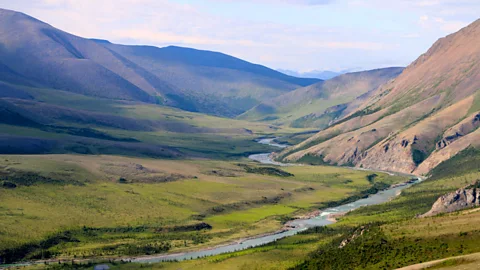
Visited by only 75 or so people a year, Canada’s Ivvavik National Park is so remote, many of its beautiful peaks remain unnamed.
We had been fishing
for hours when Manny finally landed the big one. Not that I minded. He had
warned me that the fishing might be slow; most of the schools of arctic char had
already migrated further north, into the Arctic Ocean. But nestled into a cleft
on the riverside rock at the intersection of Canada’s roaring Sheep Creek and ferocious
Firth River, on the very northernmost tip of the Yukon Territory, I became lost
in a sort of northern reverie, taking in the purple and green of the surrounding
mountains as the aquamarine Firth frothed at my feet. At one point I actually fell
asleep, awakening with a start as I fumbled for handholds in the ancient
granite so I wouldn’t tumble – feet over fishing rod – into the violent, extremely
frigid temperatures below.
I was in Ivvavik, one of
Canada’s most stunning – and least visited – national parks. Located more than
200km above the Arctic Circle, on one of the northernmost stretches of the
Canadian mainland, Ivvavik is a difficult place to access, visited by only some
75 people per year. But those who come here are richly rewarded. Ivvavik means
“the nursery” in the local Inuvialuit language, for the big herds of porcupine caribou
that calve here every May and June, at the end of their long migration from
Alaska. It’s a place that basks in the light of the midnight sun all summer: a
far-flung park that’s so remote, many of its beautiful peaks remain unnamed, bisected
by fresh lakes and rivers.
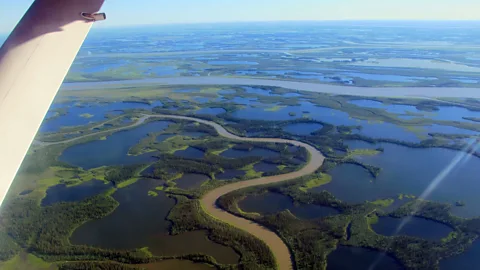
Ivvavik also is one of
Canada’s newest national parks, and the first in the world to be created out of
a land claim agreement. The area is the traditional homeland of the Inuvialuit,
a Western Arctic Inuit people. After their ancestral home became subject to
mining and drilling exploration in the late 1970s, the Inuvialuit sought to
protect it by filing an official land claim, offering the land to the federal
government in exchange for the highest degree of protection – being made a
national park. Since the matter was settled in 1984, this massive, 10,000sqkm
park, has been preserved but, until recently, largely unvisited.
I was part of a group
of a dozen or so visitors who had bought into a new package trip by
Parks Canada, which includes meals, tent accommodations and most importantly,
charter flights from the Northwest Territories town of Inuvik. We boarded a
hardy Twin Otter airplane, flying west over the uncounted ponds and lakes of
the famed Mackenzie Delta. Nearing its ultimate destination in the shimmering
waters of the Beaufort Sea (part of the Arctic Ocean), the mighty Mackenzie
River splits into literally thousands of tiny waterways that range across 13,5000sqkm.
Having traversed the Delta, we dipped over the sculpted peaks of the British
Range, flying to the extremely remote Sheep Creek Warden Station, which
comprised the only structures in Ivvavik. After first completing a fast
fly-over to confirm that no grizzly bears or wolves were on the runway, we
bumped down on the plane’s big, hearty tundra tires, making a slightly
harrowing – if entirely routine – bush landing on the 250m landing strip.
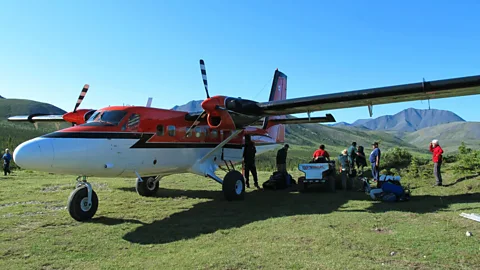
Manny, along with a
small group of Parks Canada staff, was there to welcome us and usher us down a
narrow path to a series of orange tents pitched on a little patch of tundra,
right next to the creek; our home for the next four days. The Sheep Creek
Warden Station is an oasis in the wilderness – a small handful of structures created
as part of a gold mining camp that now provide shelter and support, creating a
rustic sort of “glamping” experience. We ate our meals in a cook shack, and
read and relaxed in dining tents on a large deck (showers are even in the works
for next year). But camping in such a remote place is not without risks. Grizzlies
are common polar bears aren’t out of the question, and the day before our
departure, staff screened a safety video that included the instructions: if we
“encounter an aggressive bear, his intention is to eat you … if this happens,
fight for your life”. Giving
an introductory briefing up on the big deck at Sheep Creek, staff showed us how
to use a “bear banger”, a sort of flare gun that fires off a charge, creating a
loud noise that, in most cases, sends the beast running in the opposite
direction.
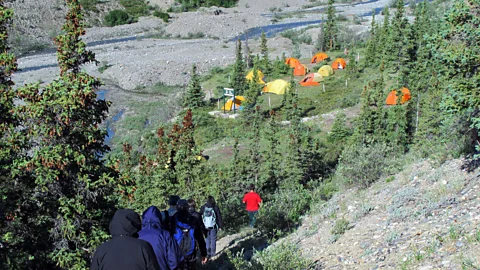
Fortunately, our days
in Ivvavik were entirely bear-free, and while there, I learned that many of the
surrounding mountains hadn’t even been named. One of the biggest had actually
gotten its moniker – Go Big or Go Home – from four Parks Canada staffers, one
of whom was on my trip. “We climbed it, then we sat down and came up with a
name for it,” said Nelson Perry, the park’s ecosystem scientist. “Once you’re
on it, you reach this point where you either have to push for the peak – or
give up and turn around. And that’s where the name comes from – you either go
big, or you might as well go home.” I didn’t push for the peak – not even close
– instead I spent some of my days simply relaxing, reading on the deck and
looking out on a line of nearby peaks, which, covered in a layer of green grass
and small bushes, appeared soft, even silky, and seemed to change colour as the
never-setting sun made its way across the sky. Fellow guest Patrice Carmichael
– a well-known Canadian painter – dubbed the same view the “Velveteen Valley”.
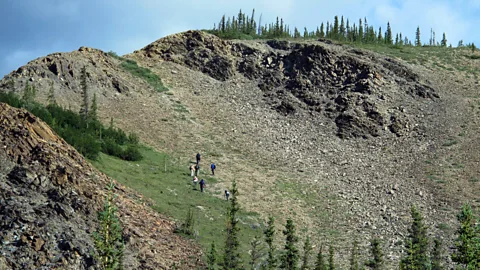
One day, Manny and I
hiked along the edge of the Firth, treading along the edges of cliffs that
plunged precipitously into the vibrant green river. As we sat down for a rest around
the halfway point, perching on smooth rocks and looking out at a big bend in
the Firth, Manny told me about how his mother was one of the key leaders in
establishing the land claim agreement that created the park. Manny – whose real
name is Dean Arey (Manny is just a nickname) – now serves on a number of related
committees, as well working part-time as a cultural liaison inside Ivvavik.
“I’m proud of what we’ve done here. There’s no mining or oil; it’s all about
protecting the land,” he said, a small smile playing on his lips.
Manny grew up in
Aklavik, a tiny, extremely remote village – and at 150km to the east, the
closest community to Ivvavik – that still serves as his home. At one point in
the 1950s, the Canadian government moved to shut down Aklavik, which is prone
to floods, and move all of its residents to the newly built Inuvik; they
refused, creating the town’s motto, “Never say die”.
As a full-blooded Inuvialuit
man and an unofficial elder, Manny uses his treaty rights to harvest the land
year-round. Even in such a harsh environment – a place where temperatures can
reach 50C (yes) below zero in the winter – the land provides some 75% of his
sustenance. He hunts and traps muskrat, caribou and bear for their meat and
pelts, driving an ATV or hiking up into the hills to find them. He even
harpoons beluga whales, navigating a boat out into the labyrinth of the
Mackenzie Delta, then sharing the meat and blubber with others in the
community. “We don’t waste anything, and want people to respect the land and
its animals,” he said. “It’s the way I was brought up, and I’m passing that
along to my sons.”
But Manny’s outdoorsy
skills certainly didn’t rub off on me. After narrowly avoiding my unpleasant
swim in the ice-cold Firth, I returned to my spot in that cleft in the rock. A
hundred casts later, my line remained completely unbitten, and nary a fish
would accompany me back to the camp. But I was okay with that. After all, I had
gathered a million memories of this northern wonderland. And the privilege of
treading many fresh paths – under peaks so unvisited, many didn’t even have a name
– was reward enough.


